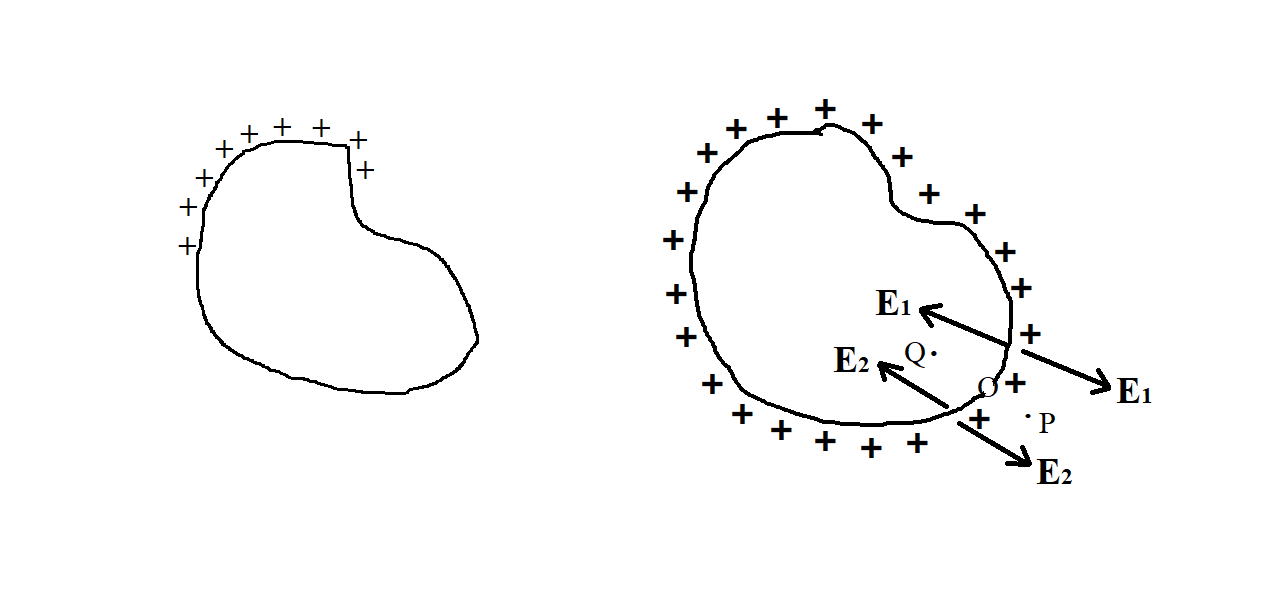
Write definition of electric field intensity.
Obtain an expression for electric force and electric pressure on the surcharge of a charged conductor.
Draw necessary diagrams.
Answer
591.3k+ views
- Hint: Electric field intensity can be determined by finding the strength of the electric field at that point. For calculating electric force and electric pressure, we will use the relation between electric field vectors and the surface density of a conductor.
Complete step-by-step solution -
Electric field intensity is expressed as the strength of an electric field at any point. This value is equal to the electric force per unit charge experienced by a test charge placed at that point.
The unit of electric field intensity is $\dfrac{\text{volt}}{\text{meter}}$or$\dfrac{\text{Newton}}{\text{Coulomb}}$.
Every element of a charged conductor experiences some normal mechanical force. This force is the result of repulsive force from a similar charge present on the rest of the surface of the conductor.
Let’s consider a small element $ds$ on the surface of a charge conductor. If $\sigma $is the surface density and the charge carried by the element $ds$ is $dq$.

Consider a point P just outside the surface near the conductor near the element $ds$. The electric field intensity at a point is given by:
$E=\dfrac{\sigma }{{{\varepsilon }_{o}}}$
The direction of the intensity is normally outwards.
The intensity consists of two components $\overrightarrow{{{E}_{1}}}+\overrightarrow{{{E}_{2}}}=\dfrac{\sigma }{{{\varepsilon }_{o}}}$
Now consider a point Q inside the conductor. The electric field vectors$\overrightarrow{{{E}_{1}}}$and$\overrightarrow{{{E}_{2}}}$at this point are oppositely directed. The electric field intensity inside a charged conductor is zero.
$\begin{align}
& \overrightarrow{{{E}_{1}}}-\overrightarrow{{{E}_{2}}}=0 \\
& \overrightarrow{{{E}_{1}}}=\overrightarrow{{{E}_{2}}} \\
\end{align}$
As $\overrightarrow{{{E}_{1}}}+\overrightarrow{{{E}_{2}}}=\dfrac{\sigma }{{{\varepsilon }_{o}}}$
For point inside charged conductor $\overrightarrow{{{E}_{1}}}=\overrightarrow{{{E}_{2}}}$
Therefore, $2{{E}_{2}}=\dfrac{\sigma }{{{\varepsilon }_{o}}}$
${{E}_{2}}=\dfrac{\sigma }{2{{\varepsilon }_{o}}}$
${{E}_{2}}$ is the electric field due to the charge on the rest of the conductor. Therefore, repulsive force experienced by element $ds$ carrying charge $dq$ is given by:
$\overrightarrow{f}=\overrightarrow{{{E}_{2}}}\centerdot dq$
$F=\dfrac{\sigma }{2{{\varepsilon }_{o}}}dq$
$f=\dfrac{\sigma }{2{{\varepsilon }_{o}}}\times \sigma \cdot ds$
$F=\dfrac{{{\sigma }^{2}}ds}{2{{\varepsilon }_{o}}}$
The electric pressure on surface $ds$ will be
$\text{pressure = }\dfrac{\text{force}}{\text{area}}$
$\text{pressure =}\dfrac{\text{ }\dfrac{{{\sigma }^{2}}}{2{{\varepsilon }_{o}}}ds}{ds}$
$P=\dfrac{{{\sigma }^{2}}}{2{{\varepsilon }_{o}}}N{{m}^{-2}}$
Electric force experienced by $ds$ on a charged conductor is, $F=\dfrac{{{\sigma }^{2}}dq}{2{{\varepsilon }_{o}}}$
Electric pressure on $ds$ of a charged conductor is, $P=\dfrac{{{\sigma }^{2}}}{2{{\varepsilon }_{o}}}N{{m}^{-2}}$
Note: While calculating the electric field at any point, direction of the vector should be considered very carefully. Also remember that the electric field inside a conductor is zero because free charges in a conductor reside only on the surface.
Complete step-by-step solution -
Electric field intensity is expressed as the strength of an electric field at any point. This value is equal to the electric force per unit charge experienced by a test charge placed at that point.
The unit of electric field intensity is $\dfrac{\text{volt}}{\text{meter}}$or$\dfrac{\text{Newton}}{\text{Coulomb}}$.
Every element of a charged conductor experiences some normal mechanical force. This force is the result of repulsive force from a similar charge present on the rest of the surface of the conductor.
Let’s consider a small element $ds$ on the surface of a charge conductor. If $\sigma $is the surface density and the charge carried by the element $ds$ is $dq$.

Consider a point P just outside the surface near the conductor near the element $ds$. The electric field intensity at a point is given by:
$E=\dfrac{\sigma }{{{\varepsilon }_{o}}}$
The direction of the intensity is normally outwards.
The intensity consists of two components $\overrightarrow{{{E}_{1}}}+\overrightarrow{{{E}_{2}}}=\dfrac{\sigma }{{{\varepsilon }_{o}}}$
Now consider a point Q inside the conductor. The electric field vectors$\overrightarrow{{{E}_{1}}}$and$\overrightarrow{{{E}_{2}}}$at this point are oppositely directed. The electric field intensity inside a charged conductor is zero.
$\begin{align}
& \overrightarrow{{{E}_{1}}}-\overrightarrow{{{E}_{2}}}=0 \\
& \overrightarrow{{{E}_{1}}}=\overrightarrow{{{E}_{2}}} \\
\end{align}$
As $\overrightarrow{{{E}_{1}}}+\overrightarrow{{{E}_{2}}}=\dfrac{\sigma }{{{\varepsilon }_{o}}}$
For point inside charged conductor $\overrightarrow{{{E}_{1}}}=\overrightarrow{{{E}_{2}}}$
Therefore, $2{{E}_{2}}=\dfrac{\sigma }{{{\varepsilon }_{o}}}$
${{E}_{2}}=\dfrac{\sigma }{2{{\varepsilon }_{o}}}$
${{E}_{2}}$ is the electric field due to the charge on the rest of the conductor. Therefore, repulsive force experienced by element $ds$ carrying charge $dq$ is given by:
$\overrightarrow{f}=\overrightarrow{{{E}_{2}}}\centerdot dq$
$F=\dfrac{\sigma }{2{{\varepsilon }_{o}}}dq$
$f=\dfrac{\sigma }{2{{\varepsilon }_{o}}}\times \sigma \cdot ds$
$F=\dfrac{{{\sigma }^{2}}ds}{2{{\varepsilon }_{o}}}$
The electric pressure on surface $ds$ will be
$\text{pressure = }\dfrac{\text{force}}{\text{area}}$
$\text{pressure =}\dfrac{\text{ }\dfrac{{{\sigma }^{2}}}{2{{\varepsilon }_{o}}}ds}{ds}$
$P=\dfrac{{{\sigma }^{2}}}{2{{\varepsilon }_{o}}}N{{m}^{-2}}$
Electric force experienced by $ds$ on a charged conductor is, $F=\dfrac{{{\sigma }^{2}}dq}{2{{\varepsilon }_{o}}}$
Electric pressure on $ds$ of a charged conductor is, $P=\dfrac{{{\sigma }^{2}}}{2{{\varepsilon }_{o}}}N{{m}^{-2}}$
Note: While calculating the electric field at any point, direction of the vector should be considered very carefully. Also remember that the electric field inside a conductor is zero because free charges in a conductor reside only on the surface.
Recently Updated Pages
The number of solutions in x in 02pi for which sqrt class 12 maths CBSE

Write any two methods of preparation of phenol Give class 12 chemistry CBSE

Differentiate between action potential and resting class 12 biology CBSE

Two plane mirrors arranged at right angles to each class 12 physics CBSE

Which of the following molecules is are chiral A I class 12 chemistry CBSE

Name different types of neurons and give one function class 12 biology CBSE

Trending doubts
What are the major means of transport Explain each class 12 social science CBSE

Draw ray diagrams each showing i myopic eye and ii class 12 physics CBSE

Derive an expression for electric potential at point class 12 physics CBSE

Explain the formation of energy bands in solids On class 12 physics CBSE

Draw a neat and well labeled diagram of TS of ovary class 12 biology CBSE

The graph between angle of deviation and angle of incidence class 12 physics CBSE




